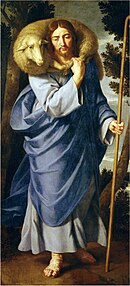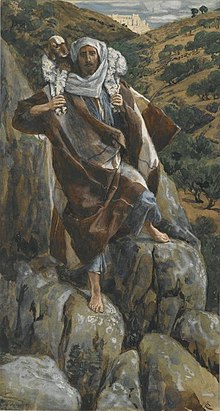User:This lousy T-shirt/Parable of the Lost Sheep

The Parable of the Lost Sheep is one of the parables of Jesus. It appears in two of the Canonical gospels of the New Testament, as well as in the non-canonical Gospel of Thomas.[1]
According to the Gospels of Matthew (18:12–14) and Luke (15:3–7), a shepherd leaves his flock in order to find the one sheep who is lost. It is the first member of a trilogy about redemption that Jesus tells after the Pharisees and religious leaders accuse him of welcoming and eating with "sinners."[2] The two parables which follow (in Luke's Gospel) are those of the Lost Coin and the Prodigal Son.
Narrative[change | change source]
In the Gospel of Luke, the parable is as follows:
He told them this parable. "Which of you men, if you had one hundred sheep, and lost one of them, wouldn't leave the ninety-nine in the wilderness, and go after the one that was lost, until he found it? When he has found it, he carries it on his shoulders, rejoicing. When he comes home, he calls together his friends and his neighbors, saying to them, 'Rejoice with me, for I have found my sheep which was lost!' I tell you that even so there will be more joy in heaven over one sinner who repents, than over ninety-nine righteous people who need no repentance."
— Luke 15:3-7, World English Bible

Interpretation[change | change source]
The parable shares themes of loss, searching, and rejoicing with the Parable of the Lost Coin.[2] The lost sheep or coin represents a lost human being.
As in the analogy of the Good Shepherd, Jesus is the shepherd, thus identifying himself with the image of God as a shepherd searching for stray sheep in Ezekiel 34:11–16.[2] Joel B. Green writes that "these parables are fundamentally about God, ... their aim is to lay bare the nature of the divine response to the recovery of the lost."[3]
The rejoicing of the shepherd with his friends represents God rejoicing with the angels. The image of God rejoicing at the recovery of lost sinners contrasts with the criticism of the religious leaders which prompted the parable.[3]
Depiction in art[change | change source]

The image from this parable of the shepherd placing the lost sheep on his shoulders (Luke 15:5) has been widely incorporated into depictions of the Good Shepherd.[4] Consequently this parable appears in art mostly as an influence on depictions of the Good Shepherd rather than as a distinct subject on its own.
Hymns[change | change source]
While there are innumerable references to the Good Shepherd image in Christian hymns, specific references to this parable can be recognised by a mention of the 99 other sheep.
Perhaps the best-known hymn describing this parable is "The Ninety and Nine" by Elizabeth C. Clephane (1868), which begins:
There were ninety and nine that safely lay
In the shelter of the fold.
But one was out on the hills away,
Far off from the gates of gold.
Away on the mountains wild and bare.
Away from the tender Shepherd’s care.
Away from the tender Shepherd’s care.[5]
References[change | change source]
- ↑ Gospel of Thomas: 107 Lamb translation and Patterson/Meyer translation.
- ↑ 2.0 2.1 2.2 Richard N. Longenecker, The Challenge of Jesus' Parables, Eerdmans, 2000, ISBN 0802846386, pp. 201–204.
- ↑ 3.0 3.1 Joel B. Green, The Gospel of Luke, Eerdmans, 1997, ISBN 0802823157, p. 526.
- ↑ Walter Lowrie, Art in the Early Church, Pantheon Books, 1947, ISBN 1406752916, p. 69.
- ↑ The Cyber Hymnal: The Ninety and Nine.
External links[change | change source]
- Biblical Art on the WWW: The Lost Sheep
- The parable in the book of Luke, NIV version
- The parable in the book of Matthew, NIV version
Lost Sheep, Parable of the Category:Bible Category:Christianity Category:Jesus Christ
